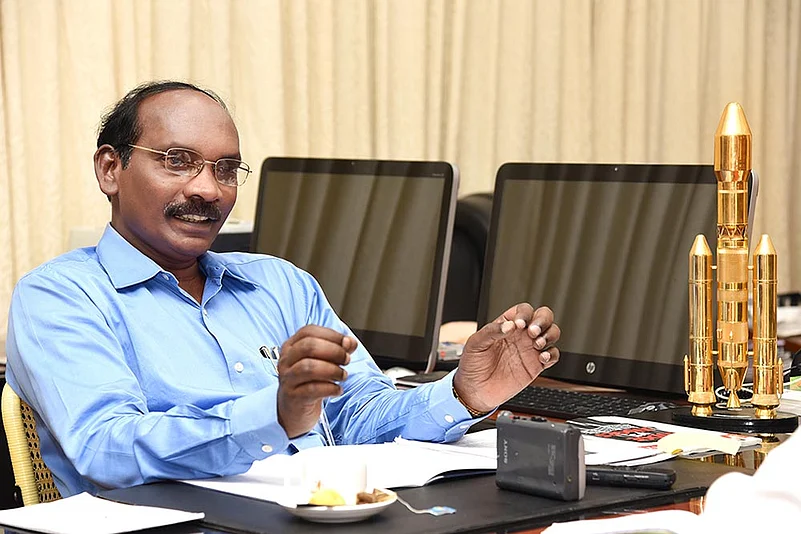The times are exciting for the Indian Space Research Organisation, as it readies to launch satellites into the geostationary orbit using swifter and less complicated indigenous vehicles. With the recent launch of a geosynchronous satellite launch vehicle—GSLV Mark III—ISRO has mastered the cryogenic propulsion system. As the GSAT-19E satellite orbits 36,000 km away in space, one of its architects, K. Sivan, the director of Vikram Sarabhai Space Centre, Thiruvananthapuram, talks to Minu Ittyipe.
What is motivating ISRO to be world-class compared to other government organisations?
Right from the beginning, I have noticed that people are allowed to do things on their own. The atmosphere is so free that their imagination can soar; so they try to outperform others. The system in ISRO is slightly different: the effort of the boss down to the technician is the same. Each person is responsible for his/her work. Even on a Sunday, we are willing to work.
What kind of talent are you looking to attract?
One can study any engineering or science discipline and there will be a space in ISRO. We are attracting the best talents. We have a lot of projects with the IITs. ISRO has a policy o bring in academicians and industry.
By 2020, will India finally have a manned mission?
No, because government has not approved the human space mission yet. It’s still in the discussion stage in ISRO.
How much has ISRO benefited from the Vikas Engine (liquid propulsion)?
Vikas Engine is a game-changer in ISRO technology. Till then, it was solid propulsion system. Vikas Engine development was the first step toward achieving a world-class higher payload capable vehicle. Liquid engine has high-specific impulse, flexibility and higher capability. All our vehicles have the Vikas engine.
The idea was to launch a bigger 4-tonne satellite for better efficiency. But the vehicle we had at hand, GSLV Mark II, was not capable of launching a 4-tonne satellite; so we had to develop a vehicle from scratch. We wanted both a capable vehicle and a low-cost one. A simpler and robust vehicle. The success of any launch vehicle in the first go is very rare. We are all elated. It has been years of hard work.
How long did it take to develop GSLV Mark III?
Fifteen years. The target was for 2008. We already had the solid propulsion and the liquid propulsion. We lost 4-5 years in between because the manpower and resources were diverted to the cryogenic upper stage. When the GSLV Mark II failed, we had to come out of the failure—and do the analysis, and start afresh. Once we successfully demonstrated in 2014, we then concentrated all our energy on this cryogenic stage. We have only one testing facility.
What is the difference between Russian model GSLV Mark II and the indigenous GSLV Mark III model?
In 2010, after GSLV Mark II failed, we were looking at 4-tonne satellites as the next step. And we needed a bigger cryogenic stage and almost three times higher thrust than the GSLV Mark II for a 4-tonne satellite. That was our requirement. The handicap was unless the entire system was available, we could not do the test. So we had to have a new engine and new cryogenic stage. But in the indigenous stage, as soon as we get one component, we can do the testing. This way, the understanding of the engine was better and we could carry out the test sequentially and then go for integration.
The next plan is to launch a six-tonne satellite. Why can’t you make lighter satellites?
There is an effort to do that. What can be done by the 6-tonne satellite can be done by a 4-tonne satellite too. Once the satellite is launched in the geosynchronous transfer orbit (between 170 km to 36,000 km from the earth), it uses its own propulsion system to takes itself from the transfer orbit to the final geostationary orbit, which is 36,000 km from the earth, along the equator. The satellite has its own propulsion system to circulate the orbit. The electric propulsion requires only about 300-400 kg and the rest can be satellite mass. So the benefits we can achieve by a 6-tonne satellite, we can with a 4-tonne satellite if we use the electric propulsion system.
This means the cost of communication should come down drastically.
Yes, it will come down.
The commercial implications of using ISRO’s facilities to launch satellites of other countries?
PSLV is already doing the service for 22 countries. Of the 104 satellites launched, 101 were commercial satellites.


























